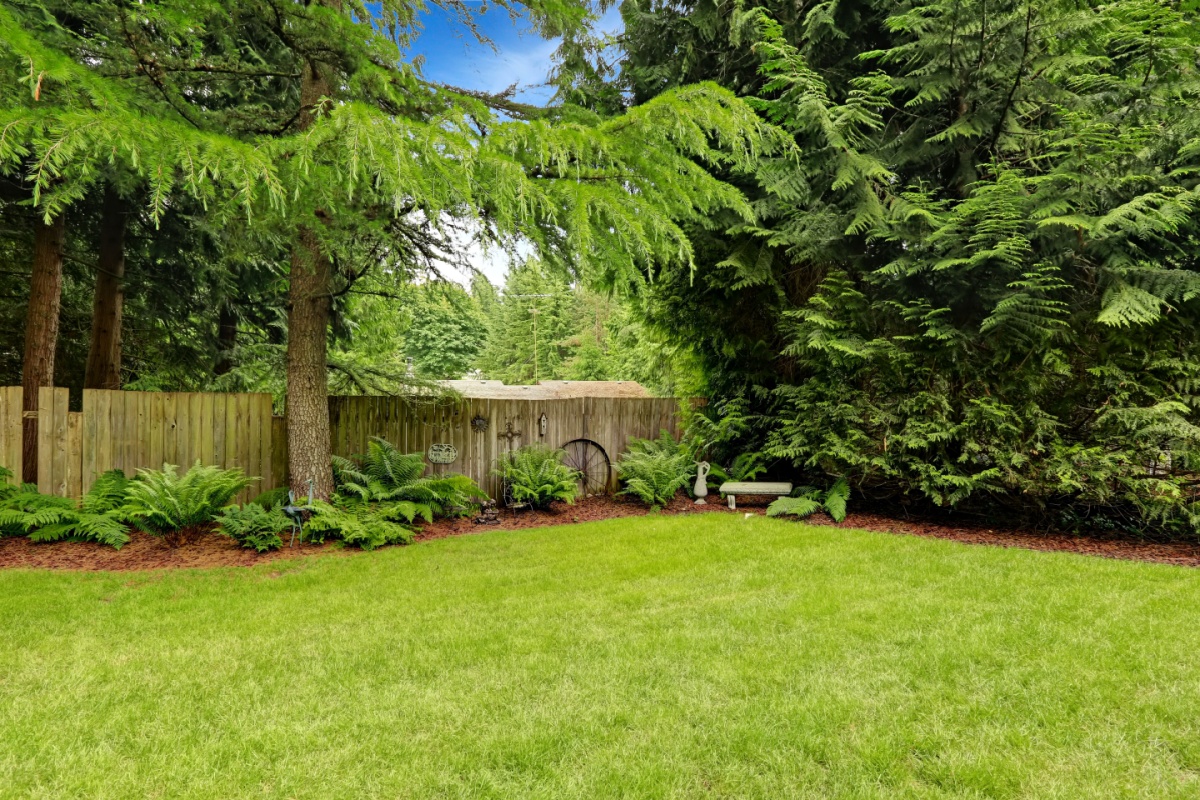
Trees are surprisingly self-sufficient. Unlike houseplants or a well-kept lawn, they don’t need daily watering or trimming to survive. But just because they can get by on their own doesn’t mean they thrive without a little help. If you’re wondering what you can do to keep your trees healthy, we’re here to pave the way forward.
Water Your Trees Carefully
While mature, established trees have extensive root systems designed to find their own water, periods of drought or extreme heat can put them under significant distress. For this reason, it’s important to maintain a regular watering schedule.
With mature trees, it’s best to water deeply rather than frequently to encourage root growth. A good rule of thumb is to give your trees a slow, deep soak that penetrates 12 to 18 inches below the surface. A soaker hose or a drip irrigation system that spirals around the tree’s dripline (the area directly under the outermost branches) is a great way to achieve this.
As you water your trees, make sure to avoid watering too close to the trunk; instead, focus on the area beneath the tree’s canopy where the roots actively absorb moisture. And consider watering in the early morning or late evening to help reduce evaporation and ensure your trees get the hydration they need.
Use Mulch Properly
What if there was a simple, inexpensive way to protect your trees, improve soil health, and reduce your watering duties all at once? We’re happy to tell you that there is! And it’s called mulching. Organic mulch, like wood chips, insulates against temperature extremes, retains moisture, suppresses weeds, and even adds nutrients to the soil as it breaks down.
Of course, you can’t just dump a pile of mulch around your tree and call it a day. Instead, you need to lay the mulch carefully. The best practice involves creating a mulch ring 2 to 4 inches deep, starting a few inches away from the trunk and extending out as far as the canopy reaches.
Before we move on to the other tips on keeping your trees healthy, we want to make sure you noticed something important about mulching: you should never pile the mulch against the trunk of the tree. This practice traps moisture against the bark, which can lead to decay, fungal diseases, and insect infestations. It can also cause the roots to grow into the mulch pile instead of deep into the soil, creating instability. The correct method is to create a “donut” of mulch, with the mulch starting about 6 inches away from the base of the trunk.
Leave Tree Pruning to Certified Arborists
Does that overgrown branch hanging low over your driveway tempt you to grab a saw and take care of it yourself? While the DIY spirit is admirable for things like interior painting or building a bookshelf, tree pruning is one area where professional expertise is paramount. In fact, tree work is one of the most dangerous jobs in the world, and that fact alone should have you stepping away from the pruning shears.
Since pruning often involves removing large dead or dying branches, the work should be performed by a certified arborist who is trained in tree biology. These professionals know how to make the right cuts at the right time of year to encourage healthy growth, improve airflow through the canopy, and remove problematic branches without compromising the tree’s integrity. They can also identify potential hazards you might miss and perform the work safely with cranes and rigging.
So, instead of risking improper cuts that create wounds that the tree cannot heal or structural weaknesses that may not be apparent until the next big storm, invest in professional tree pruning.
Invest in Deep-Root Fertilization
Unfortunately, the soil in North Carolina’s urban and suburban environments does not have everything your trees need to thrive. This is because common landscaping practices, construction projects, and the removal of natural leaf litter can leave soil depleted of the essential nutrients trees need for vigorous growth. The good news is that deep-root fertilization can bridge the gap.
Unlike lawn fertilizers that only cover the surface of your yard, deep-root fertilization delivers nutrients directly to a tree’s root zone, several inches below the soil line. This targeted approach promotes robust root development, enhances foliage color and density, and improves the tree’s overall resilience to pests, diseases, and environmental stress. An ISA-certified arborist can assess your soil and your tree’s specific needs to determine the right fertilizer blend and the best time to apply it.
Be Aware of & Treat for Common Pests & Diseases in North Carolina
Being a vigilant observer of your trees and any changes in appearance they may experience is a key part of keeping them healthy. So, regularly inspect your trees for signs of trouble, such as discolored or distorted leaves, unusual growths, fine webbing, sawdust-like material (frass) at the base of the trunk, or dead branches.
If you notice anything out of the ordinary, don’t wait to contact a certified arborist to diagnose the problem. They have the expertise and the tools to identify the specific pest or disease and recommend the most appropriate and environmentally responsible treatment plan.
Some of the most common pests and diseases to be aware of in North Carolina include:
- Emerald Ash Borer: This destructive, metallic green beetle targets ash trees by boring into their trunks and cutting off nutrient flow. Signs of an infestation include a thinning canopy, D-shaped exit holes in the bark, and increased woodpecker activity.
- Spotted Lanternfly: The invasive planthopper has gray forewings and bright red hindwings and feeds on a wide variety of trees, including maples, oaks, and willows. They excrete a sticky substance called honeydew and leave behind gray, putty-like egg masses on trunks in the fall and spring.
- Ambrosia Beetles: These beetles attack stressed trees and introduce fungal pathogens that can be fatal.
- Cankerworms: These caterpillars defoliate trees by eating leaves, which weakens the tree over time. You might notice leaves being eaten or see the caterpillars dangling from silk threads.
- Aphids: These small sap-sucking insects can cause leaf curling and excrete honeydew, which promotes mold growth.
- Scale Insects: These pests attach to branches and suck sap, leading to stunted growth and branch dieback.
- Powdery Mildew: The fungal disease typically targets crape myrtles and dogwoods and creates a white powdery coating on leaves, reducing photosynthesis.
- Anthracnose: This fungal infection (common on dogwoods and oaks) causes leaf spots, premature leaf drop, and twig dieback.
- Root Rot: Often triggered by overly moist conditions, this disease attacks the roots, compromising the tree’s stability and nutrient absorption.
Help Your Trees Recover From Storms
In the aftermath of a storm, your trees may look worse for wear, with broken branches hanging precariously, torn bark highlighting a crack in the trunk, and roots pulling up from the ground. If your first instinct is to break out the chainsaw, take a step back. Major structural issues, split limbs, and uprooted trees require a professional to determine the best course of action. After all, attempting to remove large, heavy branches without the proper equipment and training is extremely dangerous.
An ISA-certified arborist can determine if a tree can be saved with corrective pruning, cabling, or bracing. And if removal is necessary, they can do so without risking additional damage to your property.
Prepare Your Trees for Future Storms
Storm damage isn’t always avoidable, but proactive tree care goes a long way in keeping your trees healthy in the face of extreme weather. For example, structural pruning can prevent disasters during storms by selectively thinning the canopy to allow wind to pass through more easily, rather than hitting it like a solid wall. It also includes removing or reducing the length of overly long, heavy branches that could act as levers in high winds, which ultimately puts immense strain on the trunk.
Cabling and bracing are other techniques that can reinforce mature trees with weak forks or heavy limbs. If your trees are in a flood-prone area, improving soil drainage and elevating root zones may help mitigate stress. Even proper tree selection matters since native species tend to fare better in local weather conditions. For more ideas on tree preservation, speak to the certified arborists at Heartwood Tree Care.
Contact Heartwood Tree Care & Find Out What Your Tree Needs the Most
While many homeowners think of tree care as an “as-needed” task, it’s actually important to schedule routine inspections with an ISA-certified arborist even if you haven’t noticed any visible changes in the tree’s appearance. With these in-depth health checks, our professionals at Heartwood Tree Care can spot signs of trouble before they become serious problems and recommend strategies to support long-term health.
For a comprehensive tree inspection and to learn even more essential tips for keeping your trees healthy, contact us today. We are dedicated to protecting the health and beauty of the canopies that make up the rich appearance of our community and look forward to partnering with you.
